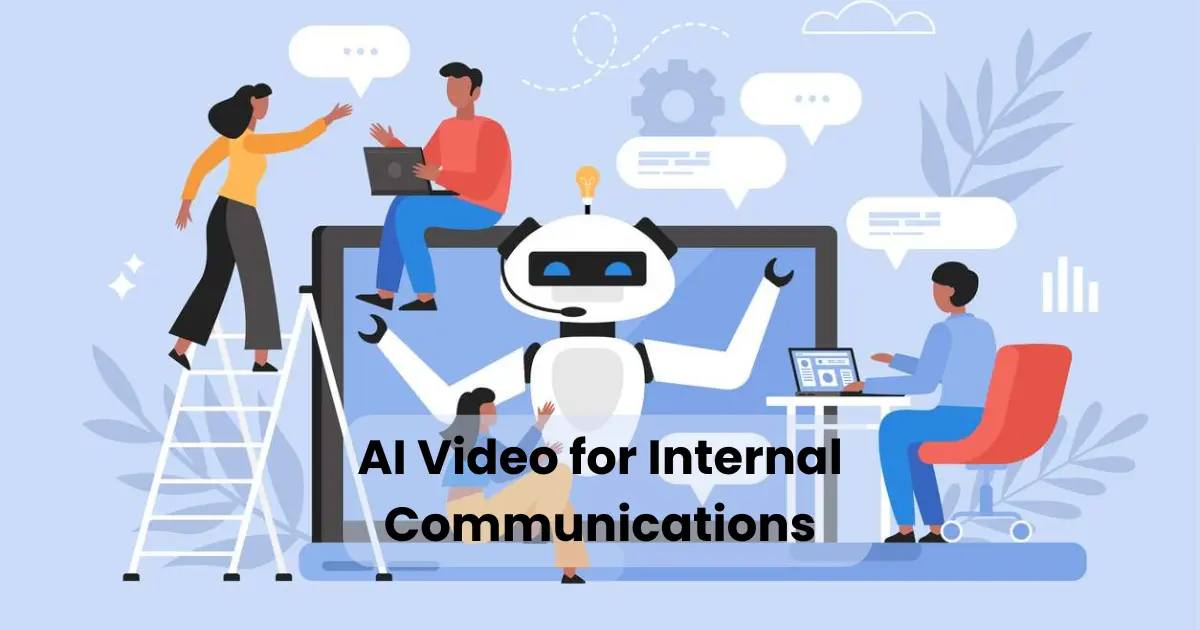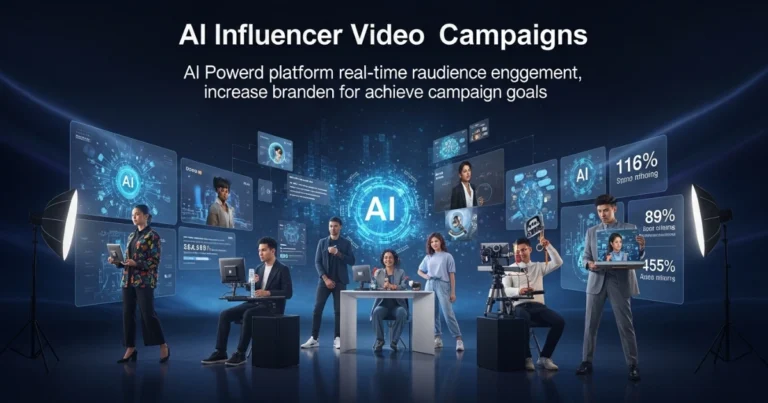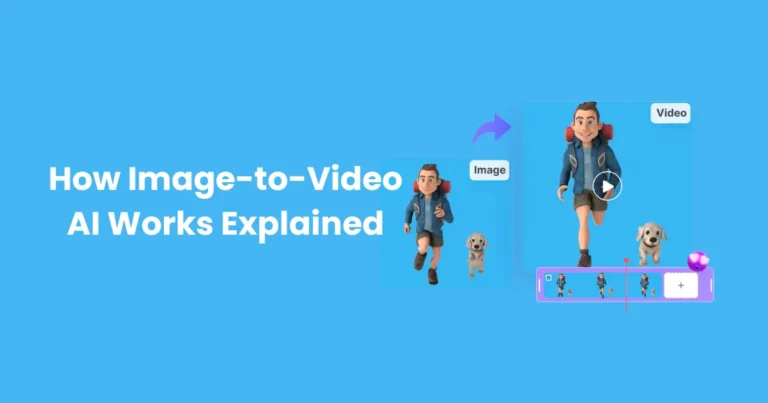AI Video for Internal Communications

Contents
- 1 What Is AI Video for Internal Communications?
- 2 Benefits of Using AI Video in Internal Communication
- 3 Applications of AI Video for Internal Communications
- 4 How AI Video Is Created for Internal Communications
- 5 Best Practices for Implementing AI Video for Internal Communications
- 6 Challenges and Considerations
- 7 Future Trends of AI Video in Workplace Communication
In today’s fast-paced and digitally connected workplaces, AI video for internal communications has been recognized as a game-changing solution. Designed to replace static emails and long text updates, AI-powered videos have been adopted by forward-thinking organizations to enhance how information is shared internally.
While traditional communication methods often resulted in inconsistent messaging or low engagement, a more dynamic and uniform approach has been introduced through AI technology. AI video for internal communications enables companies to deliver engaging, multilingual, and personalized content with minimal manual effort.
Moreover, since these videos can be generated rapidly and at scale, they offer both time and cost efficiency. As a result, corporate communication has been improved significantly, especially in large, distributed teams. In the sections that follow, the benefits, use cases, and best practices for AI video will be thoroughly explored.
What Is AI Video for Internal Communications?
AI video for internal communications refers to the use of artificial intelligence to automatically create and distribute video content tailored for an organization’s internal use. These videos are typically generated by AI platforms that combine natural language processing, text-to-speech technology, avatars, and visual design templates to transform written messages into compelling visual content.
Instead of requiring a full video production team, scripts can be input into an AI system, and professional-looking videos can be produced in minutes. As a result, even small HR or communication teams can now deliver consistent, branded video messages across departments.
In many cases, AI video for internal communications is used to streamline company updates, deliver training content, onboard new employees, or reinforce corporate culture. Furthermore, videos can be localized in multiple languages using automated translation tools, ensuring inclusivity in global organizations.
By leveraging AI, internal communications are made faster, more engaging, and less resource-intensive—transforming how teams connect and collaborate.
Benefits of Using AI Video in Internal Communication
The adoption of AI video for internal communications has grown rapidly—and for good reason. It brings a wide range of benefits that directly address the evolving needs of modern organizations.

1 Enhanced Engagement
First and foremost, employee engagement is significantly increased. Traditional formats like emails or PDFs are often overlooked, while AI-generated videos are more likely to capture attention. With the use of lifelike avatars, dynamic visuals, and clear narration, messages become more immersive. Consequently, employees are more likely to understand and retain the information being shared.
2 Consistency in Messaging
Additionally, AI video for internal communications ensures that messages are delivered uniformly across all teams, departments, and locations. This consistency is especially important in large or international companies, where variation in communication can lead to misunderstandings or misalignment. With AI, the same message can be produced and distributed at scale—without distortion.
3 Cost-Effective Communication
Previously, video production required substantial budgets and long lead times. Now, AI video for internal communications allows businesses to generate professional content within minutes and at a fraction of the cost. Not only are savings made on production, but internal teams are also freed from repetitive manual tasks.
4 Time Efficiency
Moreover, speed is a major advantage. Updates, announcements, or training sessions can be turned into videos almost instantly. Because the content is created and edited quickly, organizations are able to respond to changes and share updates in real time. As a result, communication becomes more agile and responsive.
5 Multilingual Accessibility
Finally, global teams benefit from multilingual support. Most platforms that offer AI video for internal communications also provide automatic translation and subtitle options. Therefore, language is no longer a barrier, and inclusivity is greatly enhanced.
Applications of AI Video for Internal Communications
The versatility of AI video for internal communications allows it to be used across a wide variety of internal functions. From employee onboarding to executive announcements, AI video content ensures that communication is efficient, engaging, and scalable.

1 Onboarding and Training
To begin with, one of the most common applications is in employee onboarding and training. New hires can be welcomed with personalized videos, helping them feel more connected from day one. Furthermore, AI-generated training modules can simplify complex topics through visual explanation, ensuring that learning materials are consistent and easily understood.
For companies that hire frequently or operate in multiple locations, AI video for internal communications makes it possible to maintain the same high standard of training without requiring live sessions or manual repetition.
2 Company Updates and Announcements
In addition, AI video is ideal for communicating company news, policy changes, or strategic updates. Rather than sending lengthy emails that might be ignored, leadership teams can deliver visually appealing videos. These videos can include data visualizations, voiceovers, and branded elements, making the message more memorable.
Because AI video for internal communications can be created quickly, it is also well-suited for urgent or time-sensitive announcements.
3 Cultural Alignment
Another critical application lies in reinforcing company values and workplace culture. For example, diversity and inclusion messages, ethical training, or mental health initiatives can all be delivered more impactfully through AI video. By combining relatable avatars with multilingual capabilities, these messages resonate across various regions and demographics.
Ultimately, AI video for internal communications helps companies align employees with their mission and goals in a way that’s both human and scalable.
How AI Video Is Created for Internal Communications
Creating AI video for internal communications involves several automated steps that transform written content into polished video messages. While the process may seem complex at first glance, it is largely streamlined through user-friendly platforms powered by artificial intelligence.

1 Script Generation or Input
To begin, a script must be written or imported. This could be a company announcement, onboarding guide, or policy explanation. In many cases, existing internal documents are simply repurposed. Then, the content is reviewed and refined to ensure clarity and tone. Once finalized, the script is fed into the AI platform.
2 Voice Selection and Avatar Design
Next, a voice style and avatar are chosen. Voiceovers are generated using AI text-to-speech engines, offering a wide range of accents, tones, and languages. Additionally, a virtual presenter—either animated or photo-realistic—is selected to deliver the content. Custom avatars can be created to reflect brand identity or diversity goals.
Thanks to these tools, AI video for internal communications can be tailored to the specific needs and culture of the organization.
3 Visual Styling and Branding
Afterward, visual elements are added. Backgrounds, logos, fonts, and colors are applied to match the company’s branding guidelines. Some platforms also support automatic animation of text, charts, or infographics to make information more engaging.
4 Video Rendering and Distribution
Once the content is finalized, the video is rendered. This process is handled entirely by the AI platform and completed within minutes. Then, the video is ready to be distributed across internal channels such as Slack, Microsoft Teams, email, or the company’s intranet.
As a result, the production cycle is shortened dramatically, and AI video for internal communications can be deployed swiftly and repeatedly without the need for editing software or professional videographers.
Best Practices for Implementing AI Video for Internal Communications
To achieve the maximum impact from AI video for internal communications, it is essential to follow best practices that align with communication goals, company culture, and employee needs. When implemented thoughtfully, AI video can become an integral part of internal messaging.
1 Define Clear Objectives
First, it is important to clarify what the video is intended to achieve. Whether the goal is to inform, train, motivate, or align employees, the message must be focused and goal-oriented. This ensures that the AI-generated content supports specific business outcomes rather than serving as just another communication format.
2 Keep Content Concise and Engaging
Moreover, the content should be brief and easy to digest. Most employees are busy and may not have time for lengthy videos. Ideally, AI video for internal communications should run between 60 to 180 seconds—long enough to convey key points, but short enough to maintain interest. Interactive elements or animated visuals can be included to boost engagement.
3 Use Branding Consistently
In addition, the video should visually reflect the company’s identity. Branded avatars, custom color palettes, and corporate logos help reinforce recognition and trust. Furthermore, maintaining a consistent tone across videos improves professionalism and credibility.
4 Enable Multilingual Support
Especially in global organizations, offering multilingual options is vital. Fortunately, most AI video platforms provide automatic translation and voiceover in multiple languages. As a result, inclusivity is enhanced, and employees across different regions receive the same message without barriers.
5 Gather Feedback and Iterate
Finally, feedback should be actively collected after videos are shared. Surveys, engagement metrics, or simple viewer comments can reveal how well the message was received. Over time, this input helps refine the use of AI video for internal communications, ensuring that content continues to meet the evolving needs of the workforce.
Challenges and Considerations
While AI video for internal communications offers numerous benefits, there are also challenges that must be acknowledged. For successful implementation, potential limitations should be understood and addressed proactively.

1 Risk of Over-Automation
To begin with, one significant concern is the potential for over-automation. If every message is delivered through AI without human oversight, communication may feel impersonal or overly robotic. Employees may become disengaged if they sense that empathy or nuance is lacking. Therefore, a balance must be maintained between automation and authenticity.
2 Limited Customization in Some Tools
Although many platforms offer impressive features, not all allow for full customization. In some cases, avatars may appear generic or voiceovers may sound unnatural. As a result, the final product might not align with the tone or culture of the organization. Careful selection of AI video tools is essential to ensure a good fit.
3 Data Security and Confidentiality
Furthermore, when sensitive internal content is handled by third-party AI systems, data security becomes a concern. Confidential company updates or HR communications must be protected. Before adopting any platform, its compliance with privacy regulations such as GDPR or HIPAA should be verified.
4 Resistance to Change
Another challenge lies in adoption. Employees and leadership teams may resist new tools, especially if they are unfamiliar with AI technologies. To ease this transition, it is recommended that AI video for internal communications be introduced gradually, supported with training and clear demonstrations of its value.
5 Quality Control
Finally, maintaining consistent quality can be difficult if too many videos are produced without review. Errors in tone, script, or branding may go unnoticed. Thus, content should be proofread and previewed before distribution to ensure it aligns with company standards.
Future Trends of AI Video in Workplace Communication
As technology continues to evolve, AI video for internal communications is expected to play an even more prominent role in shaping the future of workplace interactions. New advancements in AI, personalization, and automation are likely to redefine how internal content is created, delivered, and experienced.

1 Hyper-Personalized Messaging
To begin with, future AI systems will likely focus on hyper-personalization. Instead of generic messages, internal videos could be tailored to each employee’s role, department, or preferences. For instance, onboarding videos might automatically adjust their tone and content based on the viewer’s experience level or learning style.
Thanks to machine learning, AI video for internal communications will become more adaptive and responsive to individual needs.
2 Real-Time Video Generation
Additionally, real-time video creation is expected to become mainstream. Executives and managers may soon be able to type out a message and instantly generate a branded, avatar-led video for their teams. This not only improves agility in communication but also ensures that time-sensitive updates are shared immediately.
3 Integration with Collaboration Platforms
Furthermore, seamless integration with tools like Slack, Microsoft Teams, and Notion will increase. AI-generated videos will be embedded directly within daily workflows, making internal communications more accessible and consistent.
Because of this shift, AI video for internal communications will no longer be an isolated solution but a core element of digital workplace ecosystems.
4 Emotionally Intelligent Avatars
As natural language processing becomes more advanced, AI avatars are predicted to become more emotionally intelligent. They will recognize the emotional tone of the script and adjust their expressions and voice delivery accordingly. In this way, the emotional impact of internal messaging will be strengthened—even when delivered through automation.
5 Cross-Device Optimization
Lastly, AI video will be optimized across devices—from smartphones and laptops to wearable tech. Whether employees are in the office, remote, or on the move, internal communication will reach them in the most effective format, wherever they are.
Undoubtedly, the evolution of AI video for internal communications will bring smarter, faster, and more human-like messaging to the heart of corporate culture.
Conclusion
In conclusion, AI video for internal communications is transforming the way companies connect with their employees. Through automation, personalization, and scalability, internal messages can now be delivered faster, more consistently, and with greater engagement than ever before.
While certain challenges—such as maintaining authenticity and ensuring data privacy—must be managed, the long-term advantages are undeniable. With AI, communication can be made more inclusive, especially in global workplaces, and video content can be updated or repurposed as needed without additional production costs.
Moreover, as the technology continues to advance, new trends like emotionally intelligent avatars and real-time video generation will further enhance the effectiveness of internal messaging. When used strategically, AI video for internal communications not only simplifies operations but also strengthens company culture and alignment.
For organizations aiming to modernize their communication strategies, now is the time to embrace AI-powered video—because the future of workplace communication is already here.






